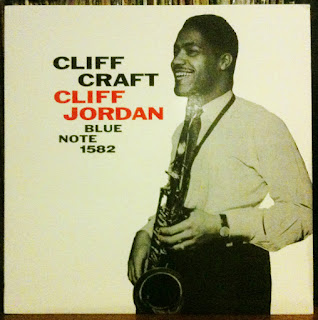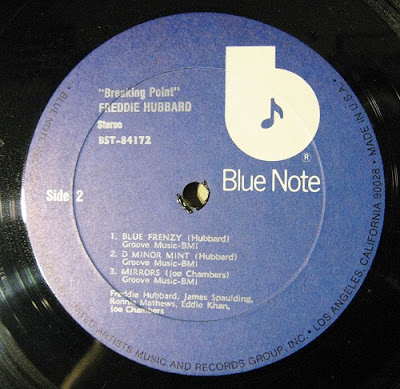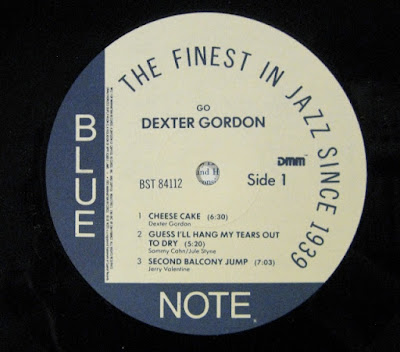Are you struggling to pick up on all of this Blue Note record label minutia?
Believe me, I know how tough it is at the start of your journey trying to track this record label stuff down.
Understanding what original and reissue really means was a daunting task.
I have been a Blue Note jazz aficionado for nearly 20 years, I didn't catch the Blue Note vinyl collecting bug for better than 10 years into that journey.

With
auction prices reaching lofty heights, you better know what you're doing, both buying and selling, or you could lose your shirt.
Below I will show you photos of labels from my collection, these will highlight the labels that serve as a guide for pressing identification. I had to learn this stuff or else risk getting burned buying and selling on eBay.
I will also go over what terms like RVG in the dead wax mean, what the trademark R's importance is; also what the abbreviation (DG) means, and why it so overused on eBay listings. We can't forget that all important EAR in the dead wax either.
You can use the table of contents in the side bar to jump to things quickly you might be looking for
Notice below labels had subtle changes throughout the early years, then drastic changes after Blue Note was Sold to Liberty. Pay attention to the addresses for the pre 1967 records, then it's more fuzzy as you go forward through the 1970's where the non traditional colors become the identifying feature.
767 Lexington Ave NYC (1951-1957)
This is where it all starts, at least 12 inch LP Blue Note collecting anyway. Every single record released with the Lexington address is a mono copy, Blue Note did not release a stereo issue until 1959. Horace Silver's "Stylings of Silver" has the honor of being the first. These are generally all deep groove.
Also I would like to make the point that these
original Lexington Blue Notes in VG+ to Near Mint Condition are commanding insanely high $1,000 plus prices.
Jutta Hipp, Hank Mobley, and Lee Morgan vinyl are fetching well over $3,000. Don't be discouraged, I find lesser condition copies of these at thrift stores and record shops all the time, with multiple marks per side some times.
The record is VG minus at best, but people will still pay 10% of Mint value if the cover is VG. Surface noise, ticks and pops can be lived with, but skips can not, a skipper might bring you 5% of Near Mint.
You can't forget though, that it's all about supply and demand, and both of those factors fluctuate so much, you can see some wild price fluctuations. Sometimes when selling a lesser grade copy, it's just happenstance, someone stumbles by and sees a record that sells for $3,000 Near Mint, but can't resist the idea of having a Good to VG minus condition copy for $150.
I sold this pictured copy for that much, I bet the buyer was thrilled. I didn't hear anything negative, they were probably so happy that they received a record that played better than the visual grade.
That's the thing about the Lexington's, they hold up well to moderate marks and scuffs. I distinctly remember that deep bass sound, or at least the bottom end on these being very impressive.
Surprisingly, these hold up well to moderate marks and scuffs. in fact, the photo of the Johnny Griffin label above is one such record I found that plays very well.
I paid 5 dollars for it. All of the Lexington addressed Blue Notes are mono, and they do sound good, this particular label usually boasts very robust and detailed sound. With these thick Lexington LP's, they always seem to have a deep, well recorded bass, and everything seems closer to the microphone.
Sometimes though, you run into a hiss sound, not the normal surface noise, a moderate distortion? I'm thinking this is
groove wear. After so many spins the vinyl will degrade, I am sure that 50's era equipment was not as delicate as it became... So I can see why mint copies bring such extravagant prices.
Note: Thanks to a kind gentleman for straightening me out about the"767" and not "161" on the Lexington Label.
47 West 63rd New York 23 (1957-1958)
This particular Label has stereo and mono "microgroove" recordings, sometimes you will find these with the "Inc." after Blue Note Records up near the address.
later on, the New York 23 was dropped and only the 47 West 63rd is left. The pictured record is a perfect example of the type of original Blue Note that won't destroy your budget.
I picked this Jimmy Smith record up for 5 bucks at a local record shop, the vinyl playing surface was graded liberally at VG, a few marks that I could feel. The record still sounds way above average, I am truly amazed at quality of these, even in less than average condition.
They are always worth a gamble, even if typically the condition makes you cringe a bit. Some staunch collectors are not huge fans of organ jazz, but I like it, and will not apologize for it. Here's another Jimmy Smith find, a trio of Blue Note's found at the local Goodwill thrift store.
47 West 63rd NYC (1958-1962)
This particular label used from 1958 to 1962 also began the stereo era at Blue Note. This was the label where the trademark circled "R" started being used under the E in NOTE, any records that saw their original issue prior to 4018 with the R are not original.
This Blakey LP pictured does not have the "R", therefore it
is an original first press Blue Note. If one has the trade mark R before 4018, then it is not an original
.
The address reads Blue Note Records, if it reads Blue Note Records Inc. It would not be an original unless that record's first issue had the Inc.
NY USA (1962-1966)
The New York USA label is the end of an era really, the end of this address marked the end of Plastylite pressed records. Alfred Lion's association with the label ended, and unfortunately after the 1966 Liberty buyout, the quality of the record cover art suffered as well.
I have several 2nd press New York USA label Stereo's that match or surpass the original 47 West mono copies for what it's worth. The Jackie McLean Bluesnik, and even the Blakey Moanin' LP, I don't know what to make of this really?
These will not have the Ear/P in the dead wax, so ask questions if you need a true NY USA copy, that Ear
must be in the dead wax.
Division of Liberty Inc. (1966-1970)
This is where things get confused and really tricky, 1966 is where Alfred Lyon sold Blue Note to Liberty Records. This is also where Plastylite was dumped as the pressing company, and soon
Reid Miles was no longer designing covers anymore.
One of the confusing things, and I learned the hard way: Liberty at this point was still using NY USA Labels on their records which were not stamped by Plastylite, and the vinyl quality seems inferior to me as well on those if you compare.
But please understand this quality I speak of, can be splitting hairs. I have learned during my 4o plus years, one mans trash is another man's treasure, so check for yourself.
The quality difference is not nearly enough in my opinion to keep you from saving massive cash on Liberty issues.
I ran across a few of The 3 Sounds LP's several years ago, they were NY USA Labels, but there was no Plastylite P/Ear in the dead wax.
I had no idea about this Liberty using old NY USA labels stuff. Months later, after more research and comparisons, it was obvious the quality was inferior.
In essence these were just Liberty Pressings Masquerading as NY USA copies. Now please understand that the sound difference wasn't so wide that I wanted to throw the record away, but the point is, I paid a premium for that record and it was not a real NY USA. The seller perhaps didn't know that the EAR's meaning meant such a difference.
I would highly suggest if you're eBay shopping, and someone says "NY USA", ask about the Plastylight P, and make sure that RVG or VAN GELDER is somewhere in the dead wax. Then you know it's a real NY USA.
Remember if they say its original, or say there's an EAR, and there isn't one, that's out right fraud. Unknowingly or knowingly, who knows? If they don't mention the details that make it what you want, don't assume, in the end you have to be the one to find out.
Liberty U.A. Black Label (1970-1971)
This black label Liberty U.A. pressing might be the rarest of all Blue Note Labels, only used briefly after the year 1970, these usually sound pretty good too.
I like these sound wise over the blue and white Liberty pressings, usually these will have the VAN GELDER stamp in the dead wax. At least two first pressings I know of with this label, McCoy Tyner's Expansions and Ornette Coleman's Love Call.
I did do a cross comparison on Brother Jack McDuff's Moon Rappin', Tyrone Washington's Natural Essence, and Lee Morgan's Live at the Lighthouse: I could not tell any discernible difference in the sound between the Blue and White label pressing and this black label press.
I recently tested a Lee Morgan Candy, and a John Coltrane Blue Train, I though the records sounded fantastic, with a crisp clarity. I didn't weigh these, but it seems these are heavier than some of the blue and while label Division of Liberty, perhaps they are?
Division of United Artists Label (1971-1973)
These United Artist's pressings seem to be much lesser quality material wise, the vinyl is thinner and they don't hold up well to surface marks.
There are other variations of these Blue and White label ones too: Sometimes 1972 will be under the the Produced by note: Also, blue track and production notes instead of the black ink pictured above. Just know that this United Artist blue and white label is dated 1971-1975.
The one perceivable thing that does stick out when testing the 70's as opposed to the 50's and early 60's presses is the depth of sound.
I mentioned before, the full sound, the ability of the early labels to sound good even in VG or less condition. It's absolutely there, the oomph is missing in the overall clarity. Sometimes new "2000's" reissues sound better to me than these 70's issues.
The black b pressings though sound better, and the vinyl thickness seems better, but it is common knowledge now that the weight of the vinyl doesn't necessarily equal great sound. The composition of the vinyl, its purity is what counts.
Division of United Artists Black b Label (1973-1978)
The "black b" Blue Note pressing is known as the poor man's deep groove Blue Note. It is a decent sounding record, PLUS the 70's era covers are still thick and have that vintage look and feel. This seems to be mainly a re-issue label, with the white b being new titles.
These are rising fast in price now that the other pressings have shot beyond expensive prices. Most U.A. black b's can be had from $10-40 dollars, some titles though like Sam Rivers, Grachan Moncur III, and Jackie McLean can approach $100. Generally all releases are stereo, and VAN GELDER is stamped in the dead wax, these do offer underrated quality sound in my opinion.
Many times I have compared these Mid 70's pressings to earlier pressings, while nothing beats the early 1951-1957 pressings for sound, these black b pressings are very good, and very reasonably priced. Perhaps the sound gap isn't as wide as many audiophiles say?
United Artists Blue Note Reissue Series (1975-ish)
This label was primarily used for the mid 70's 2-fer LP's, that featured many of the significant Blue Note artists and many unreleased sessions, out of print, or newly discovered sessions.
These particular sets can be found at
bargain prices, and quite honestly are a hell of steel, I don't think they sound terrible, though many aren't thrilled with them, I guess the best way to state it, they are a bit of a mixed bag.
Producer Michael Cuscuna of
Mosaic Records fame, compiled many of these double albums for release. Artists like Cecil Taylor, Booker Ervin, Jackie McLean, and Freddie Hubbard are featured prominently.
Much of the music on these re-issues have also been remastered for a CD release, most times complete with brand new art work. Since a CD's running time 80 Minutes, many time most of the music can fit on one disc.
I do believe in the case of the Andrew Hill 2 fer One For One, they squeezed out a CD re-issues Pax. and 6 track appear on The
Mosaic Box #16. Hill's
Change, came from the Sam Rivers Re-issue series release Involution as well.
Division of United Artists White b Label (1975-1979)
This label was used as new titles label for blue note from 75' to 79'. I also believe those 79-80 vault releases have this same white b, "you know the ones with the redesigned and ugly covers", that look nothing like the classic Reid Miles style covers?
The original vinyl was housed in generic uniform design with an even more generic, often times completely unrelated photo on the cover. Who ever came up with the idea to jettison the original classic Blue Note style cover art should have been slapped silly.
Some of the best of this reissue series were: Larry Young's Mother Ship, Andrew Hill's
Dance With Death, and Bobby Hutcherson's Medina.
These are also very reasonably priced, except the Andrew Hill Dance With Death, which can be a bit pricey due to Andrew Hill's popularity, and it being one of his best records period.
DMM Direct Metal Mastering Label (Mid-80's)
These DMM or Direct Metal Mastering LP's from the mid 80's are widely considered to be the worst sounding Blue Note vinyl pressings. I don't think they are all that bad, but some I have, do seem to have a thinner sound than I like. This Dexter Gordon Go LP wasn't bad at all, better than the CD at least.
Some, like the record pictured, sound pretty good. Usually you can find these dirt cheap, if your patient, these 80's pressing can be had for less than 10 bucks many times.
If I see a DMM in a bargain bin under 10 dollars, I will always grab it up, these will probably be rising in price as well as the Lexington's thru NY USA are year by year becoming luxury items.
The mere mortal collector like me has to settle for these lesser priced bargains, and if you don't have a completely ridiculous audiophile ear you can still enjoy records like these. You can find this same label without the DMM though, and I have heard that many people like these, I don't think I have heard any of the non DMM of this label type.
Scorpio Label- 304 Park Ave. S. NYC (Mid 90's-2000's)
The Scorpio label is a current reissue label that I can not find much info about, the weight of the vinyl is decent but I think under 180 gram. I have a few dozen of these, I picked up a bunch when an online store was going out of business, 5 bucks a piece was hard to pass up.
The mastering quality is average at best, I had a copy of Wayne Shorter's Speak No Evil that sounded very good and seemed to have a little more punch on the bottom end. I now have a Liberty issue that does not sound better.
These were pressed at a plant called Scorpio, but reading further, knowing the plant name, I was able to find that there have been
complaints from audiophiles about the sound quality. Apparently these are nothing more than digital copies pressed to vinyl, like listening to a CD for the most part.
As I mentioned above, for the price, as a filler copy, I wouldn't have a problem with it... but if you are a real sticker, I would pass on these.
It would be a wiser decision to pay twice as much for a better quality reissue.
King Japanese reissues. The 45 RPM
Music Matters double vinyl I hear great reviews about, and I know the mid-90's Capitol EMI Connoisseur's series sound good to my ears. I do think these are pricey, but they will be in mint condition and should be free of surface noise.
*All photos are my own: Vintage Blue Note LP labels.*
*Affiliate Disclosure: Any link or photo you click could take you to another site, if you buy a product on that site, I could earn a commission. I also may place links direct to my own eBay store.



























